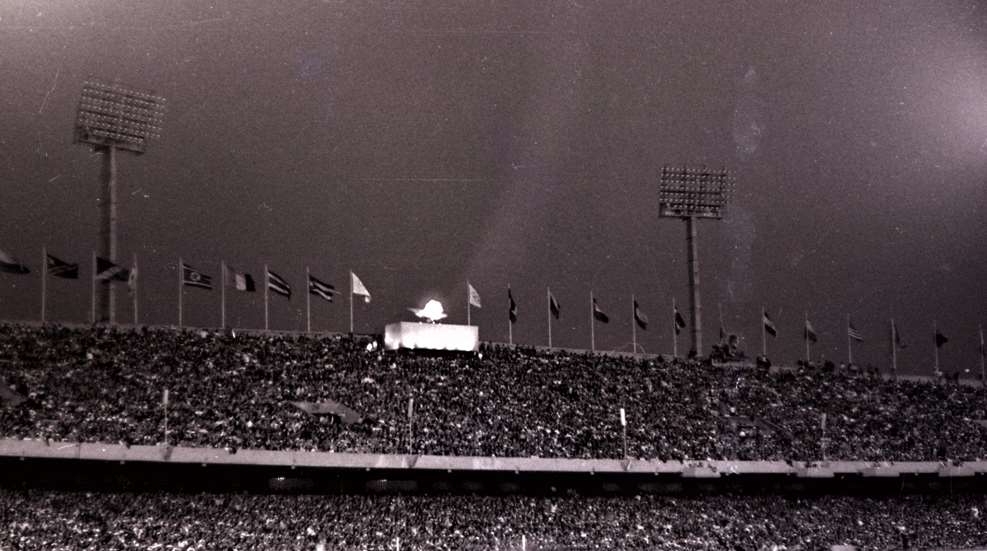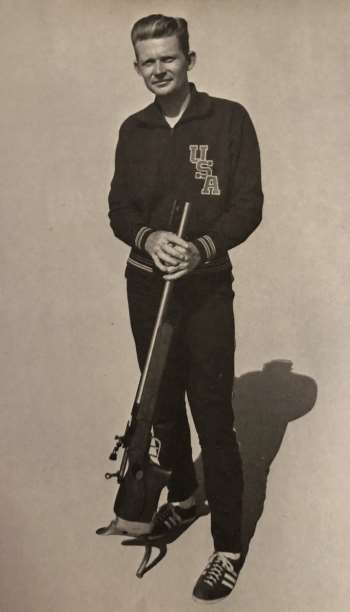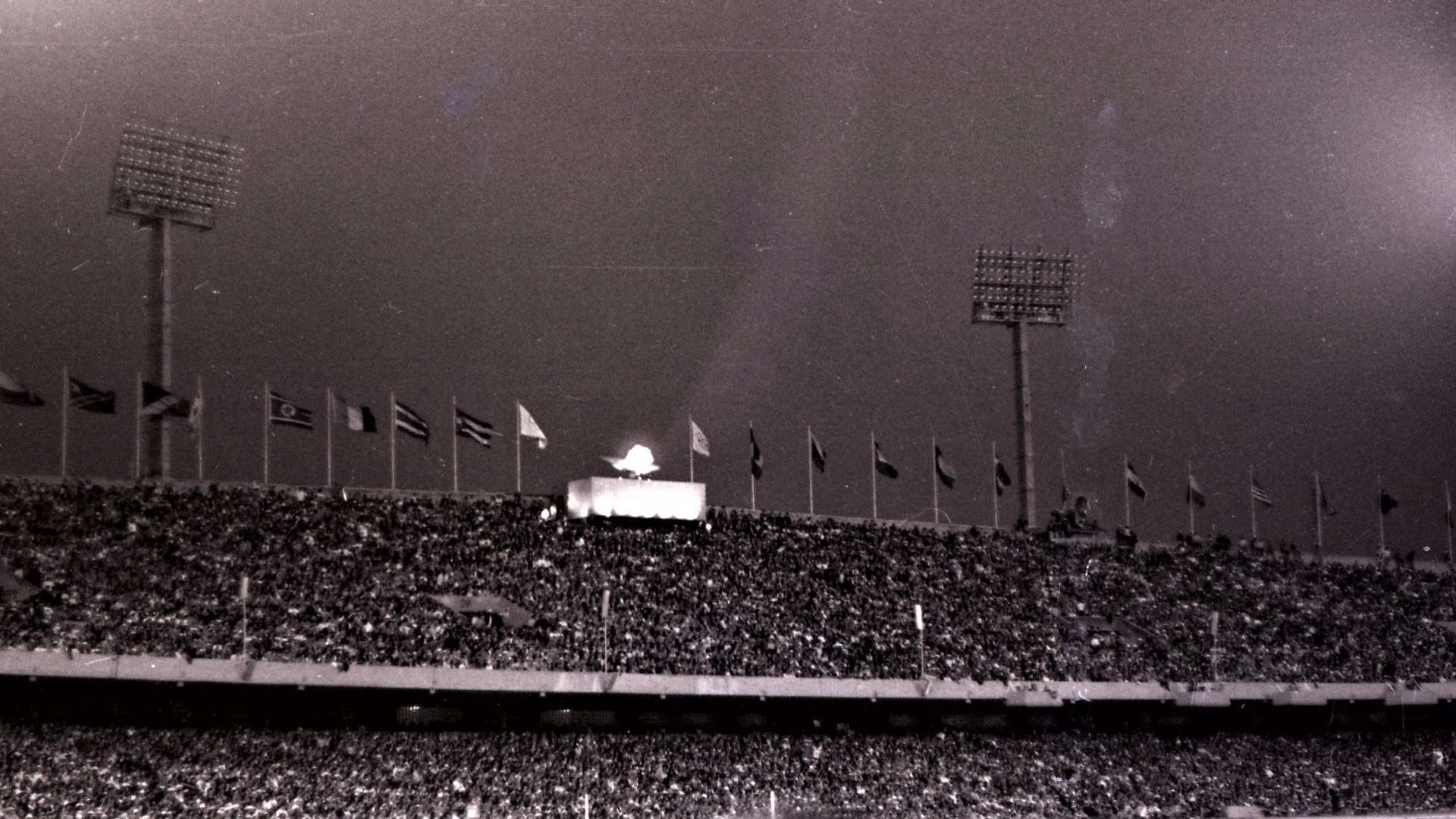
The below is an excerpt from the 1978 book, Olympic Shooting, written by Col. Jim Crossman and published by the NRA. Read Part 1, Part 2 and Part 3.
1968—Mexico City (Part 4)
By Colonel Jim Crossman
Finally came the day we had been waiting for—the start of the matches. The free pistol shooters marched off to battle with high hopes and great confidence. Both had been shooting excellent scores and both had beaten the existing world record. They did not feel out of step because they were the only shooters on the line using the Green electric pistol—and that's a story in itself.
Green's design got rid of most of the problems of other designs and worked beautifully.
Air Force Maj. Frank Green won a silver medal in the free pistol event in Tokyo using a standard Hammerli pistol with a trigger of his own design. But he thought he could design a better free pistol. As the culmination of several years' work—not to mention spending a lot of money—green made by hand five guns which represented the last word in free pistols. With all possible adjustments, they could easily be personalized for the individual shooter. But the electric firing mechanism, which gave very short and very uniform firing pin fall, was the interesting feature. Not that electric firing is so new or novel, having been tried, off and on, for 80 years or more. But Green's design got rid of most of the problems of other designs and worked beautifully.
Prior to the final tryouts, Green gave four of his pistols to the four shooters he though most likely Olympic quality and he kept one for his own use. As you already know, Green was beaten out of a place on the team by Hamilton and Vitarbo shooting Green pistols.
These pistols did look out of place on the firing line. Sixty-eight percent of the shooters used the famous Hammerli free pistol, 16 percent used a Russian gun and six percent shot an Austrian pistol. The preference in ammunition was not quite as marked. A third of the shooters used British Eley ammunition, followed by 22 percent using the German R-50, and the remainder using seven different makes and nationalities.
The confidence of the U.S. team was jolted at the end of the first 10-shot target, when Vitarbo showed a 91 and Hamilton an 89. The Olympic record for the course was 560, and we all expected that this would be broken to win the match. A 560 requires slightly better than a 93 average for the six targets. So the 91 and the 89 did not look too good, especially with nearly half the shooters getting 90 or better on the first target. The 91 was Vitarbo's low score for the match, but he did not have enough high ones to pull him up, and he ended with 559, one point below the Olympic record and one point behind the bronze medal.
Interestingly, the winner, Soviet Grigory Kosykh, also started with a 90 on his first string, but he added enough good scores to end with 568. Heinz Mertel, West Germany, also had 562, while Harald Vollmar, East Germany, took the bronze with 560. Don Hamilton's first string was his worst, but he never recovered sufficiently and ended up in 17th with 548.
On the Olympic trap field, Ray Stafford, in his first big international competition, knocked out a 24 on his first string. Tom Garrigus, shooting in the first squad, had the doubtful honor of missing the first clay bird of the 1968 Olympics when his second bird got away clean. Another miss gave him a discouraging 23 for his first string. By the end of the day, Garrigus had obviously given himself a little talk, because he had run the next three strings straight, ending up with 98. That tough Pole, Adam Smelzynski, showed his world championship caliber by leading with a 99, while there were a number of scores of 98 or 97. Stafford had lost six birds at the end of the first day.
Garrigus started the second day with 24 straight but then missed the last bird of the first round. He dropped one more bird in his next string, ending with the fine score of 196—and a three-way tie for second place. There was no question about the winner. Great Britain's John Braithwaite had broken only 23 on his first string, but then went on with 175 straight for a total of 198 and the gold medal.
In the shoot-off for second place, Pavel Senichev, USSR, dropped two birds in the first string, while Garrigus and Kurt Czekalla, East Germany, went straight. In the second string, Garrigus used his second barrel successfully, on his first bird. Czekalla also used his second barrel, unsuccessfully, on his first bird. On his 12th shot he missed another. Garrigus' 16th bird was a hard left angle which he missed with his first barrel, but he knocked a small piece off the bird with his second shot. The referee called it lost, but a howl went up from the big crowd because they had clearly seen a piece break off. The side referees, used just for this purpose, had spotted the piece also, so Tom got the bird and he went on for the 25, giving him 100 straight for his last four rounds and a well-earned silver medal.
The trapshooters were pretty consistent in their choice of equipment, with only a very few using anything other than the under-and-over shotgun. These came in a number of different makes, with the Browning being the most popular by more than a two-to-one factor. Ammunition types were more varied, with the usual load being 3¼ dram equivalent, 1¼ ounces of #7½ or #8 nickel-plated shot. Some shooters used a different load for the second barrel. Garrigus, for instance, shot Winchester 3¼-7½ for his first shot and Remington 3¾-1¼-7½ for his second. The Remington trap load had the edge with 40 percent of the shooters using it, partly because it was good and partly because it was available in Mexico, loaded by Cartuchos Deportivos de Mexico, the Remington affiliate. The Italian MB brand ran second, with the Belgian Legia Star in third.
Meanwhile, in the English Match, the shooters showed that they knew a good thing when they saw it. Nearly 75 percent of them shot the German Anschutz match rifle, and 80 percent of them used the British Eley .22 match ammunition. And nothing less than the best would do in this 60-shot prone match, at the tiny 10-ring, less than 1/2-inch across and much smaller than a dime.
With an Olympic record of 597, it was obvious that no shooter could lose many shots out of the 10-ring and hope for a medal. So it was with increasing dismay that everyone watched Gary Anderson drop one point each on his first five strings, his 595 being good for eighth place. Lones Wigger, who won a silver medal in this event and a gold in the 3-position match at the Tokyo Games, could not repeat. His 97 on the first target put him in a bad position, and the additional points he lost put him down to 25th with 592.
Czechoslovakia's Jan Kurka shot a 99 on his second and fourth targets to give him the gold medal. Laszlo Hammerl (Hungary) found his 598 ranked down to second place, while I.R. Ballinger (New Zealand) took the bronze with 597.
At the UIT 1967 Moving Target Championship in Italy, German Konrad Wirnhier had won the skeet championship, while Yuri Tsuranov and Eugeny Petrov, both of the USSR, shot it out for second and third.
The Olympic race promised to be a real battle.
The Olympic race promised to be a real battle. The first day ended with Chile's Jorge Jottar leading with a 99, followed by Petrov, Wirnhier and Italian Romano Garagnani all with 98. On the second day, Jottar dropped a few, but the other three all went straight, for a three-way tie at 198. Incidentally, Petrov's teammate Tsuranov was in fourth place with 196.
In the shoot-off, Petrov shot another straight, while the others each dropped one. In the second round, Garagnani pushed Wirnhier into third place, 25 to 23.
The Americans? They were out of the race after the second round. Both Herring and Rodale had shot very well in practice, but on the day of the match Herring started with 24 and tied it to a 22, while Rodale reversed the procedure, thus putting each four down in the first 50. They both dropped more and Herring ended with 190 in 16th and Rodale with 189 in 19th place.
Although the autoloader is the popular gun in U.S. skeet, the over-and-under is most used in international shooting. The Olympic shooters used about 25 percent autoloaders, mostly Remington Model 1100, and about 75 percent over-and-under guns, mostly Browning. A variety of skeet ammunition was used, with the biggest share (29 percent) taken by the German Rottweil.
The smallbore rifle 3-position event consists of 40 shots prone, 40kneeling and 40 standing with the .22 rifle at 50 meters, using that same tough target as in the English Match. As in the prone match, 70 percent of the shooters used the Anschutz rifle and about the same percentage used Eley ammunition.
The two U.S. shooters, Jack Writer and Jack Foster, stuck with this winning combination. These two ran nearly neck and neck, with Writer scoring 395 prone to Foster's 394, 391 kneeling to Foster's 390, and with 370 standing to Foster's 369. Writer's 1156 put him one point behind West Germany's Bernd Klingner, for a second silver medal, the U.S.'s second. Foster's 1153 put him just one point behind Vitaly Parkhimovich, USSR, and out of the medals.
The rapid-fire pistol event, shot at the turning silhouette target, calls for the judicious application of speed and accuracy. Shooting at a 10-ring about the size of a man's hand, at 25 meters, the competitor had better not miss the 10 many times, even in the four-second stage. And to make matters worse, the match is shot on two days, half the match each day, which gives the high man on the first half plenty of chance to worry.
Although accuracy is important, gun functioning is even more critical. A malfunction usually earns a refire, but the shooters cannot improve his score in the refire. Nearly everyone shot pistols designed for the .22 short, to give minimum recoil and gun disturbance, with the Swiss Hammerli being used by 50 percent of the competitors. The German Walther was second in popularity with a 30-percent figure. A dozen or more makes of ammunition were used, although Eley held a margin over all the rest.
McMillan shot one of the special High Standard pistols. He used Eley ammunition, as did Jim McNally in his modified Hammerli. McMillan, because of his tremendous competitive background, was a favorite from the beginning, but from the first string it was obvious that he was not shooting up to his practice scores. He dropped one point on each of his eight-second strings, duplicated this in his six-second stages, and had more trouble in the fast four-second stages, to end with a 290, out of the running with half the match to go. His second-half 294 gave him a 584 for 17th place. McNally got a 99 in his eight-second course, and 100 in his six-second stage, but he came undone in the four-second time and dumped 14 points. His two-day total was 580 for 25th place.
Meanwhile, Josef Zapedzki, Poland, scored 100-99-99 for a 298 first half and backed this up with a 295 the next day for a new Olympic record of 593 and the gold medal. Marcel Rosca, Romania, Renard Suleimanov, USSR, and Christian During, East Germany, shot three five-round strings at four seconds, which moved Rosca into the silver spot. Another three strings won Suleimanov the bronze medal.
With only one match to go, the U.S. contingent was in the dumps. Starting with a great squad and high expectations, it had picked up only two medals.

The U.S. team went into the last event, 300-meter free rifle 3-position, with fingers crossed and with a lot of pressure on shooters Jack Foster and Gary Anderson. Foster had shot on the 1960 team in the 300-meter event, ending in seventh place. Earlier, in Mexico, he had been out of the medals by one point in the smallbore rifle match. Anderson won the gold medal in this event at Tokyo, he held the Olympic record and he held the world record. The U.S. shooters had much riding on their shoulders—and they knew it.
Foster got off to a bad start prone with a 95, which he backed up with another 95, ending the stage with a mediocre (for him) 386. Anderson did better, with 394, but he had considerable company, as there were eight shooters with prone scores of 394 to 398. Foster came back with the good kneeling score of 386, while Anderson led the pack with 389. Foster added a 368 standing, for a total of 1140 and, once again, seventh place. His 1960 seventh place needed a score of only 1121, with 1129 winning the match.
At the end of the kneeling stage, Anderson was leading the gang by one point—not much in an Olympic shooting match. To avoid further question or argument, Anderson stood up and leisurely shot a great 374 offhand. This gave him a grand total of 1157, which was six points ahead of the next man, four points better than his own Olympic record and one point better than his own world record. Truly a great performance by a great shot.
The sum total of the U.S. endeavor, then, was one gold medal and two silver medals, along with some near-misses. While not as good a performance as turned in by the great 1964 team, it was the best the United States had done since 1924.
Why did the U.S. team not do better? There was no problem with sickness and the shooters were well adapted to the altitude. The team got in plenty of practice and knew the conditions. The team worked together well and there was no dissension in the ranks. Nearly all of the team had extensive competitive experience and included four shooters who had shot on prior Olympic teams.
The team had some great talent, as shown by their scores in other competition, in the tryouts and in practice, and were about as fine a group of people as one could get together. There were just too many shooters who picked the competition days to shoot below-average scores.
Top winners, overall, were the Russians, with two gold medals, a silver and two bronze medals.
There were not as many U.S. names on the list of winners as the team and officials had wanted. There were not as many as they had hoped for, nor as many as they had expected, although individuals had cause to be proud of some scores. But having known the team as I did, I know that everyone was doing his utmost to shoot a winning score for the United States.
And that was what Baron de Coubertin had in mind when he started this Olympic movement. As he phrased it:
"The most important thing in the Olympic Games is not to win but to take part, just as the most important thing in life is not the triumph but the struggle. The essential thing is not to have conquered but to have fought well."
And the U.S. shooters did that in 1968 in Mexico City.

Lead photo: The 1968 Olympic Games flame inside the Mexico City University Stadium. Photo by Sergio V. Rodriguez/Wikimedia Commons.
Read more: Athens 1906 Olympics: But Not For Record



































